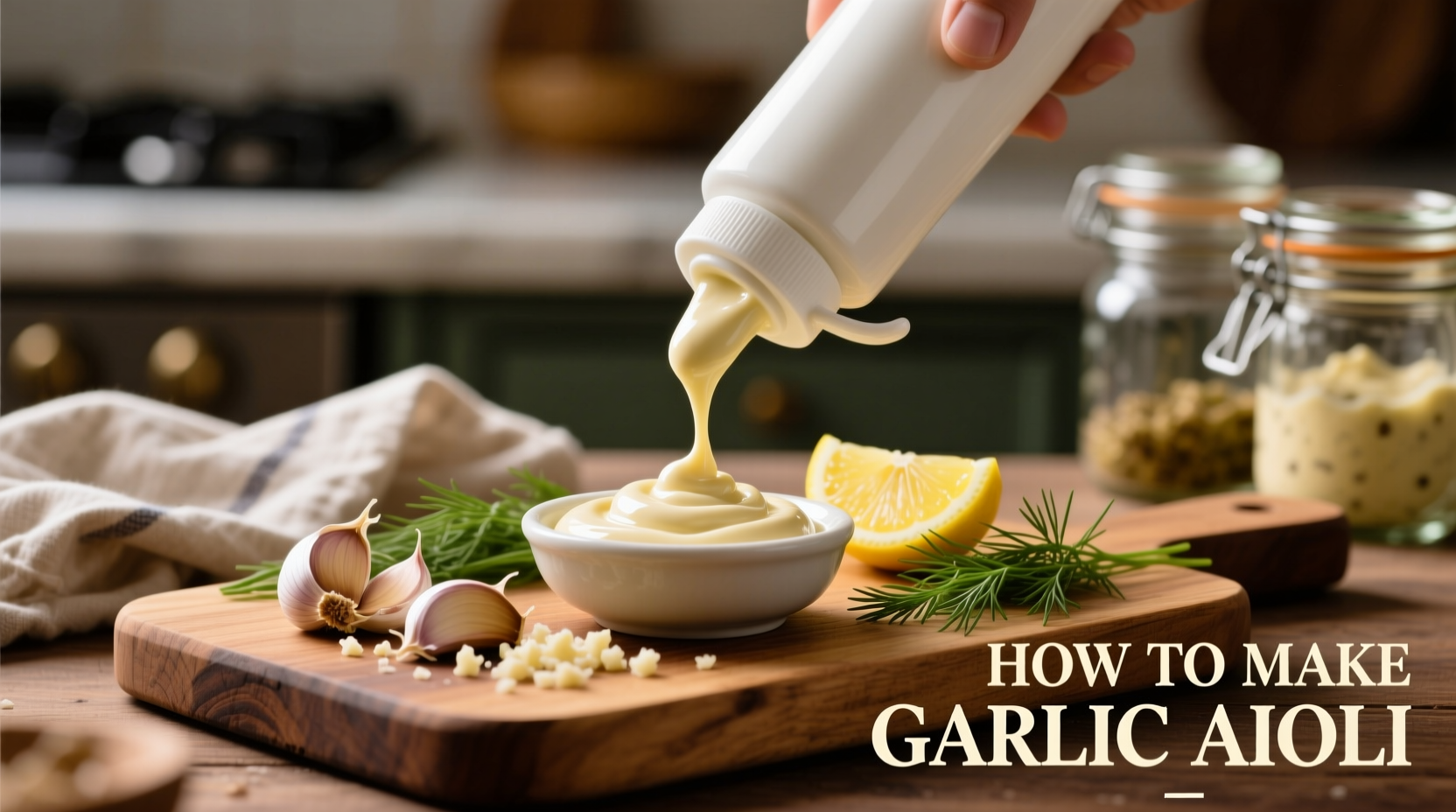Make perfect garlic aioli in 10 minutes with just 5 ingredients: egg yolks, garlic, lemon juice, Dijon mustard, and olive oil. This traditional Provençal sauce requires no mayonnaise and creates a creamy, flavorful condiment through proper emulsification technique. Follow our step-by-step guide for foolproof results every time.
Garlic aioli isn't just fancy mayonnaise—it's a centuries-old Provençal sauce with distinct preparation methods that create superior flavor and texture. As a French-trained chef specializing in European culinary traditions, I've perfected this authentic recipe through years of studying historical preparation techniques. Unlike store-bought versions loaded with preservatives, homemade aioli delivers vibrant garlic flavor and luxurious texture that transforms sandwiches, seafood, and roasted vegetables.
Why This Garlic Aioli Recipe Works
The magic of authentic aioli lies in its emulsification process. Traditional aioli (from the Catalan all i oli, meaning "garlic and oil") was originally made by pounding garlic and olive oil with a mortar and pestle. Modern methods using egg yolks create a more stable emulsion while maintaining the sauce's characteristic pungency. This recipe balances three critical elements:
- Acid balance—lemon juice cuts through richness without overpowering garlic
- Emulsion stability—egg yolks and Dijon mustard prevent separation
- Garlic preparation—raw garlic provides authentic bite without bitterness
Essential Ingredients for Authentic Garlic Aioli
Quality ingredients make the difference between ordinary and extraordinary aioli. Here's what you need:
- Egg yolks (2 large)—room temperature for optimal emulsification
- Fresh garlic (3-4 cloves)—finely minced or pressed
- Lemon juice (1½ tbsp)—freshly squeezed for bright acidity
- Dijon mustard (1 tsp)—adds depth and stabilizes emulsion
- Extra-virgin olive oil (¾ cup)—use a mild, fruity variety
- Kosher salt (½ tsp)—enhances flavor without overpowering

Step-by-Step Preparation Guide
Follow these precise steps for perfect emulsification every time:
- Prepare garlic: Mince garlic cloves finely and let sit for 5 minutes to develop flavor compounds
- Combine base ingredients: In a medium bowl, whisk egg yolks, garlic, lemon juice, Dijon mustard, and salt until smooth
- Slow oil incorporation: Begin adding olive oil drop by drop while whisking constantly—this initial phase is critical for emulsion formation
- Gradual increase: Once mixture thickens (after about ¼ cup oil), add oil in a very thin, steady stream while whisking vigorously
- Final consistency: Continue until all oil is incorporated and aioli reaches mayonnaise-like thickness
- Rest and serve: Let sit 30 minutes for flavors to meld before serving
Traditional vs. Modern Aioli Methods Comparison
| Preparation Method | Time Required | Texture | Flavor Profile |
|---|---|---|---|
| Traditional mortar & pestle | 15-20 minutes | Rustic, slightly grainy | Intense garlic, pure olive oil flavor |
| Modern emulsion (this recipe) | 10 minutes | Smooth, creamy | Well-balanced, complex depth |
| Mayonnaise-based shortcut | 5 minutes | Uniform, dense | Muted garlic, tangy aftertaste |
Troubleshooting Common Aioli Problems
Even experienced cooks encounter emulsion issues. Here's how to fix them:
If Your Aioli Breaks
Separation happens when oil incorporates too quickly. To fix:
- Stop adding oil immediately
- Whisk 1 teaspoon water or lemon juice into broken mixture
- Slowly drizzle in broken sauce while whisking a new base of 1 egg yolk
- Continue incorporating remaining oil gradually
Managing Garlic Intensity
Fresh garlic can become bitter if over-processed. For milder flavor:
- Use younger garlic cloves (less green sprout)
- Let minced garlic rest 5 minutes before mixing
- Add garlic gradually to control potency
- For sensitive palates, blanch garlic cloves in boiling water for 30 seconds
Food Safety Considerations for Raw Egg Aioli
Traditional aioli contains raw egg yolks, which presents potential food safety concerns. According to FDA guidelines, raw eggs should be avoided by pregnant women, young children, elderly individuals, and those with compromised immune systems. For safer preparation:
- Use pasteurized eggs from reputable sources (look for USDA pasteurization mark)
- Keep aioli refrigerated below 40°F (4°C)
- Consume within 3 days for optimal safety
- Discard if left at room temperature for more than 2 hours
Serving Suggestions and Pairings
Authentic garlic aioli elevates countless dishes. Try these classic pairings:
- Seafood: Perfect with grilled fish, shrimp, or crab cakes
- Vegetables: Dip for roasted asparagus, artichokes, or frites
- Sandwiches: Transform turkey, chicken, or veggie wraps
- Tapas: Essential component of Spanish patatas bravas
- Grilled meats: Complements chicken, pork, or lamb beautifully
Storage and Shelf Life
Proper storage maintains both safety and quality:
- Store in airtight container in refrigerator
- Place plastic wrap directly on surface to prevent oxidation
- Consume within 3-4 days for best flavor and safety
- Do not freeze—texture will separate upon thawing
- Discard if develops sour smell or changes color
Delicious Aioli Variations to Try
Once you've mastered the classic recipe, experiment with these authentic variations:
- Lemon-herb aioli: Add 1 tbsp chopped fresh parsley, chives, and dill
- Roasted garlic aioli: Substitute raw garlic with 4 cloves roasted garlic
- Spicy harissa aioli: Mix in 1-2 tsp harissa paste for North African flair
- Truffle aioli: Add ½ tsp white truffle oil for gourmet touch
- Herbes de Provence aioli: Stir in 1 tsp traditional French herb blend











 浙公网安备
33010002000092号
浙公网安备
33010002000092号 浙B2-20120091-4
浙B2-20120091-4